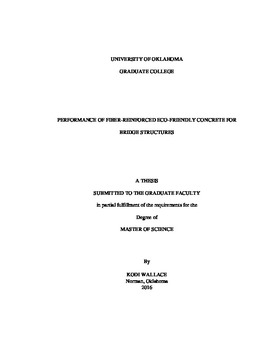| dc.description.abstract | Concrete is the leading building material in the world due to its readily available materials, strength, durability, and relatively low cost. With cities growing at a more rapid pace, the demand for concrete is increasing. Buildings, bridges, and roadways are being constructed and repaired more often than they were twenty years ago. This means that the demand for concrete is rising as well. Unfortunately, there are environmental concerns with regard to the use of concrete. The Portland cement used to manufacture concrete produces large amounts of carbon dioxide emissions, equating to approximately 5% of man-made CO2 emissions globally. In order to reduce the effects of Portland cement on the environment while still growing communities, lessening the amount of the Portland cement used in concrete could create a comparable concrete with lower environmental impact.
Reducing the amount of cementitious material in concrete can have negative ramifications. Cement takes on many different roles in a concrete mixture. Cement as part of the paste fills voids between aggregates, binds the aggregates together, and provides strength to the concrete as a whole. Reducing this part of the concrete could cause it to not perform as well as a standard concrete mix. The main objective of this research was to explore economically friendly concrete and its properties in structural design while working with local materials. This research was expected to develop an economically friendly concrete mix with a reduction in cementitious content and the use of aggregate optimization that would closely match a standard Oklahoma
xvii
Department of Transportation (ODOT) mix. Two economically friendly concrete mixes were compared to a standard ODOT Class AA mix in testing.
To evaluate shear capacity, nine full-scale beams were tested with six #7 flexural reinforcing bars. These beams were constructed using the ACI 318-14 Building Code
Requirements for Structural Concrete and tested with a third point loading test frame. The eco-friendly concrete mixes performed at the same level as the ODOT Class AA mix design in terms of fresh and hardened concrete properties and shear strength. As a result, the use of an optimized aggregate distribution can help reduce the cementitious content of concrete mixes without sacrificing performance. | en_US |
